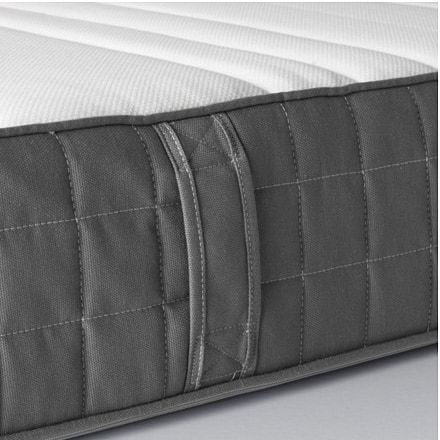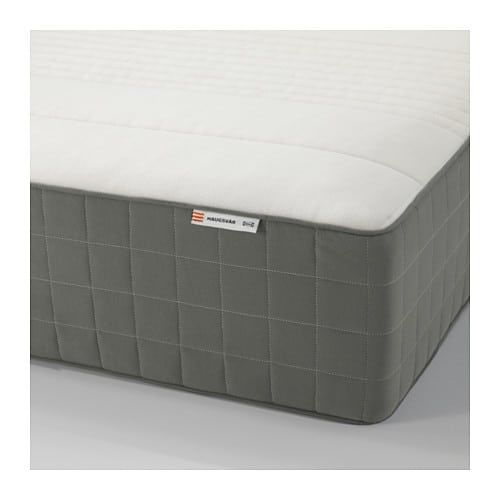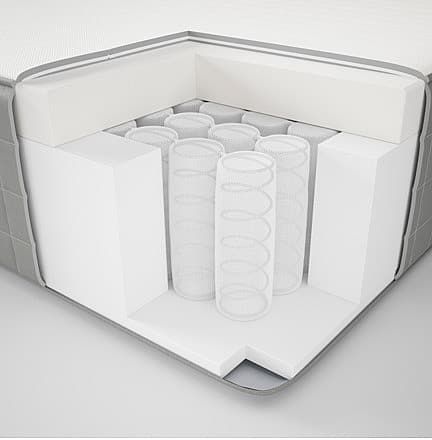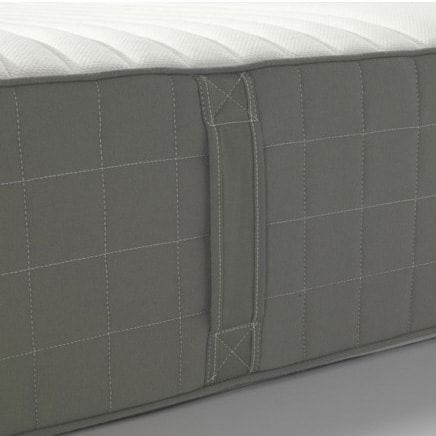Should I go with foam, or with spring? This is a question that has crossed every buyer’s mind when they’re looking at the price tags in the market. When you’re dealing with a particular brand, things normally tend to get a bit simpler.
However, IKEA’s mattresses are touted to be centered on the mainstream – which translates into economy design practices that don’t always ensure the epitome of performance. Deciding between the foam and spring mattresses that IKEA is offering then becomes a matter of careful evaluation of the features against the budget. You have to be extra careful because terms such as comfort and support cannot be taken at face value.
I’ve delved into both the manufacturer’s foam and spring mattresses for quite some time, and have put together this foam vs spring mattress IKEA comparison between the two to help you make an informed selection.
The Foam Lineup
IKEA Foam Mattress Pros & Cons
Pros
- Very cheap.
- Has some decent offerings for those on a strict budget.
- Better suited to individuals with BMIs in the neighborhood of 20.
- Work well for back and stomach sleepers.
Cons
- Not very durable, even for normal weight people.
- Only conforming options are memory foam models, which are pricey.
Core Structure
All IKEA foam mattresses consist of one or more layers of polyurethane foam – with the pricier ones also utilizing memory foam. Depending on the cost, the density and thickness of these layers ranges from 1.7 to 3.1 lb./cu.ft. and from approximately 4 to 9 inches respectively.
The relative scantiness of comfort materials does have a noticeably adverse effect on the durability and supportiveness of the mattress, but the general consensus about IKEA’s foam lineup – as far as the feel is concerned – is that they are quite firm.
There is only one foam mattress that is available in a medium-firm variant – Morgedal – but some people have found that to be quite firm too!
Durability
As can be expected from regular polyurethane foam mattresses, they offer little in terms of individualized comfort, so, while they may work for back and stomach sleepers, they definitely are problematic for side sleepers, as is evident from user feedback with many having to resort to toppers for extra cushioning.
If you want a foam mattress that provides conforming support for your body structure regardless of your sleeping posture, you’ll need to invest in the memory foam mattresses (that are obviously more expensive) – but keep in mind that these will only have the cheapest kind of memory foam, with minimal density and poor heat dissipation, so don’t expect anything on par with high end memory foam solutions.
Recommended For
Based on the materials used, and the specific quantities they are used in, it is very much evident that anyone with a BMI over 25 will not find much comfort or support with these mattresses. In fact, even those with a BMI under 25 may find that IKEA’s foam mattresses don’t last long with regular use.
However, for less taxing applications – such as children’s bedrooms, or guestrooms, these mattresses perform reasonably well considering the price.
Economy
The price for IKEA’s foam mattress lineup ranges from $89 to $599, so even at its most expensive, it is very much in the reach of budget bound consumers, which is the manufacturer’s targeted market segment for this lineup.
The Spring Lineup
IKEA Spring Mattress Pros & Cons
Pros
- Has both cheap and higher end options.
- Several good options for those who want a conforming sleeping surface.
- Work better for BMIs around 25.
- Works for side sleepers, in addition to stomach and back sleepers.
- Better durability due to greater height (doesn’t apply to cheap offerings).
Cons
- May not work well with lightweight people.
- Cheap offerings are just as flimsy as foam mattresses.
Core Structure
IKEA’s spring mattresses have comfort layers ranging from a mere fiber fill to those with multiple materials e.g. gel memory foam, polyurethane foam, fiber, and mini-springs. The comfort layer is backed by either open coils (cheaper) or pocket coils (pricier).
Where it is used, the polyfoam density is a relatively modest 1.5 to 1.8 lb./cu.ft., whereas memory foam density is at 3.1 lb./cu.ft., same as IKEA’s foam lineup. The height of these mattresses ranges from around 6 to 17.75 inches.
The majority of these products have medium-firm designations (with some having firm variants available as well) – but broadly speaking, even the medium firm is firm enough for most people’s tastes.
While the cheaper open-coil spring offerings such as Jomna and Hasvag don’t offer a noticeable improvement in terms of stress relief and support compared to the foam mattresses, things get better as you move up the pyramid.
The pricier models use multiple layers of springs – mini-coils incorporated into the comfort layer, backed by pocket coils in the base. This yields isolated, orthopedic support that ensures proper musculoskeletal alignment – perfect for back ache sufferers and side sleepers.
In particular, the Holmsbu series utilizes cooling gel memory foam (the only model in all of IKEA’s mattress offerings to do so): not only does this provide vastly improved pressure relief and individualized comfort when combined with multiple layers of pocketed coils – it also ensures better thermal dissipation for heat sensitive sleepers.
Durability
While the cheaper models are almost as flimsy as most of the foam lineup, the higher end models with heights exceeding 10” are able to handle bulkier individuals much better than the most expensive foam mattresses.
The greater height (stemming from the use of multiple spring layers and thicker materials) is able to better absorb the extra weight and therefore takes longer to develop deformities. However, the coil count on even these spring mattresses is not as high as some of the better offerings in the market, so don’t expect them to last as long.
All in all though, you can get better durability from these mattresses than the foam ones.
Recommended For
The spring mattress lineup (excluding the ultra-cheap products) is generally better suited for long term use by individuals with a BMI close to 25.
One thing to note is that the springs may not respond much to lighter weight individuals BMI close 20 (or below it), so unless they’re OK with sleeping on a somewhat stiff surface, they may want to go for the foam option.
Economy
The price of these mattresses ranges from $79 all the way up to $999, so it covers all the consumer segments covered by foam mattresses and then some.
The models with starting prices over $600 incorporate multiple individualized spring layers, as well as more generous comfort materials, so they offer better support and comfort as compared to even the priciest memory foam mattress in IKEA’s lineup.
In other words, even though they’re not accessible to cash strapped buyers the way the foam lineup is, they do come with the promise of better overall performance.
IKEA Foam Vs Spring Mattress Comparison
| Polyfoam | Spring |
|---|---|
| Very cheap | Covers foams’ price range and adds pricier, but better options |
| Generally low thickness | Has both low and high thickness options |
| Better suited for lightweight individuals | Better suited to bulkier individuals |
| Not very durable | Improved durability thanks to greater thickness and multiple supportive spring layers |
| Doesn’t have a lot of options for localized spinal support | Several pocket coil offerings that offer personalized support |
| Generally suits back and stomach sleepers | Suits side sleepers, in addition to back and stomach sleepers |
The Verdict
Mattress preferences are subjective, which is why it is tough to pick one type of mattress over the other, but speaking in terms of comfort, support and durability for an individual with a BMI between 20 and 25, I’ll have to go with the spring mattress lineup from IKEA.
Sure it has its weaker offerings (looking at Jomna and Hasvag), but it also has far superior models that perform considerably better than the top memory foam mattress in the foam lineup. That said, even the foam mattresses aren’t without use – because the spring ones may be a bit hard for lighter weight users, in which case foam will be the only affordable option for them.
Be sure to leave any feedback / queries in the comments section below.



